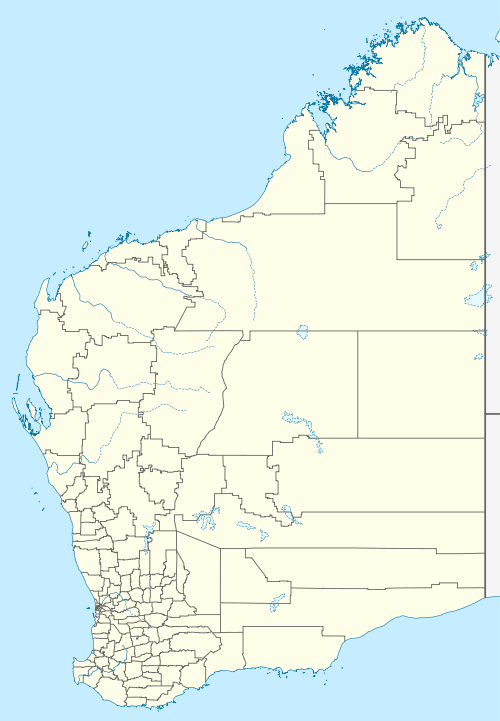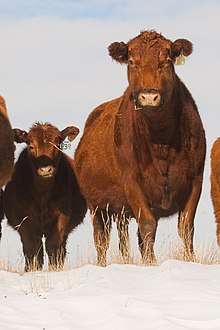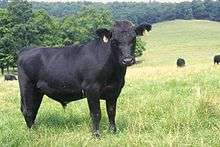Minderoo Station
Minderoo Station, commonly referred to as Minderoo, is a pastoral lease that once operated as a sheep station but now operates as a cattle station in Western Australia.

Description
It is situated about 41 kilometres (25 mi) south of Onslow and 138 kilometres (86 mi) west of Pannawonica in the Pilbara region. The property occupies an area of 2,400 square kilometres (927 sq mi) and is traversed by the Ashburton River;[1] the property has an estimated 50 miles (80 km) double frontage to the river.[2] The property spreads out from the river forming a vast plain of sand and clay.[2] The word Minderoo is Aboriginal in origin and means "place of permanent and clean water".[3]
History
The station was initially formed by E.T. Hooley who was given the pastoral lease in 1867 by the colonial Government of Western Australia as a reward for creating a stock route from Perth to Roeburne. By 1869, the local Aboriginal population began to use force to try to break the British occupation of their land. One of Hooley's shepherds, a man named Hill, was found dead and it was presumed he was killed by Aboriginals. The death was reported to authorities at Roebourne and two subsequent punitive missions were organised. The first was led by Hooley, who assembled the men working on the station and went out with them to attack a nearby native campsite. The resulting "skirmish was brief and effective". An armed Government force from Roebourne arrived a couple days later under the leadership of Farquhar MacRae. This group, together with Hooley and his men, implemented an early dawn attack on another Aboriginal settlement. The resulting episode of frontier conflict was dubbed the Battle of Minderoo. A poem was written about the battle which described it as "fierce, with casualties and woes", but the result was a massacre of Indigenous people with little wounding of the British combatants. Despite their victory in the conflict, Hooley had to abandon the property not long after, due to continued Aboriginal resistance.[4]
The property wasn't taken up again until the Forrest brothers secured the leasehold in 1878.[5] David Forrest was the initial manager, and the property was owned by his brothers, John and Alexander Forrest along with Septimus Burt.[6][7][8][9] Minderoo was owned by the Forrest family until it was sold in 1998 by Donald Forrest[10] due to relentless drought and debt. Donald's son, the mining magnate Andrew Forrest, whose early years were spent as a jackaroo at Minderoo,[11][12] bought the property in 2009[13][14] for A$12 million.[15]
Once the Forrest and Burt syndicate had acquired the lease, David Forrest overlanded 2,000 sheep to Minderoo.[5] By 1884, the property was supporting a flock of 16,000 sheep, approximately 800 cattle and 80 horses.[16]
In 1888, a fire destroyed the kitchen and its contents along with one side of the homestead; David Forrest was injured during the blaze.[17] By 1891 the size of the flock was estimated to be 50,000 sheep, cattle and horses.[2] The partnership of Forrest, Burt and Company was dissolved in 1901.[18] The Forrests were now sole owners of Minderoo and had appointed Arthur Bailey as the station manager.[19] In 1906, Minderoo was carrying a flock of approximately 33,000 sheep.[20]
Employees at Minderoo felt an air shock and heard a rumble of the first British nuclear tests on Monte Bello Island in 1952. The station was about 90 miles (145 km) from the blast site.[21] In 1954, Jack Reynolds was hired to cull feral cattle from the property. Reynolds then slaughtered and butchered the cattle and hired an Anson aircraft to deliver over 600 pounds (272 kg) of beef to Carnarvon.[22]
After buying back Minderoo in 2009, Andrew Forrest hired Phil Clark to manage the property. Clark reduced the herd size from 11,000 to 3,500 head of cattle to give the land a chance to regenerate. A weir was also installed on the Ashburton to guarantee water supply and assist in regeneration of the river.[1]
The Forrests introduced Droughtmaster, Red Angus, Ultra Black Angus bulls onto Minderoo to build a composite herd for the fine dining market. By 2015, they had announced that they would be seeking organic certification for the property.[23]
In 2017, it was reported that Andrew Forrest had plans to use centre-pivot irrigation to produce melons, onions, potatoes and sweet potatoes on up to 1000 hectares. In 2017, Minderoo Station was already producing 120 hectares of Rhodes grass as cattle feed using this irrigation method.[24]
.jpg) Droughtmaster bull
Droughtmaster bull Red Angus cattle
Red Angus cattle Black Angus heiffer
Black Angus heiffer An example of centre-pivot irrigation
An example of centre-pivot irrigation
See also
References
- Katherine Fleming (30 April 2012). "Forrest at home in red dust". The West Australian. Yahoo7. Retrieved 21 January 2014.
- "The Ashburton Goldfields". The Advertiser. Adelaide: National Library of Australia. 28 January 1891. p. 7. Retrieved 21 January 2014.
- "Minderoo – About". Minderoo Group. 2013. Archived from the original on 22 October 2013. Retrieved 22 January 2014.
- "Pioneering in the Ashburton". Sunday Times (Perth) (1085). Western Australia. 20 October 1918. p. 8. Retrieved 18 November 2018 – via National Library of Australia.
- "Program: David Forrest" (transcript). Dynasties. Australia: ABC Television. 28 November 2005. Retrieved 3 June 2012.
- Erickson, Rica (1988). The Bicentennial Dictionary of Western Australians pre-1829 - 1888. II, D-J. University of Western Australia Press. p. 1094. ISBN 0-85564-273-4. Retrieved 5 May 2018.
- Black, David; Bolton, Geoffrey (1990). Biographical Register of Members of the Parliament of Western Australia. One, 1870-1930. p. 74. ISBN 0-7316-9782-0.
- Muir, Alison & Dinee (1982). Forrest Family, Pioneers of Western Australia, 1842–1982. J.R. Muir & Son. p. 101. ISBN 0-9592883-0-9.
- B. K. De Garis and Tom Stannage. "Burt, Septimus (1847–1919)". Australian Dictionary of Biography. Australian National University.
- "Program: Forrest" (transcript). Dynasties. Australia: ABC Television. 28 November 2005. Retrieved 3 June 2012.
- "x". West Australian. 22 November 2005.
- "Summary: Forrest" (transcript). Dynasties. Australia: ABC Television. 28 November 2005. Retrieved 20 January 2014.
- Lake, Fiona (30 July 2009). "Andrew Forrest buys back Minderoo, the cattle station he grew up on". Fiona Lake blog. Retrieved 20 January 2014.
- "Forrest buys back the family farm". Farm Weekly. Western Australia. 24 July 2009. Retrieved 3 January 2012.
- "Fortescue chairman Andrew Forrest attacks Onslow's mine bid". The Australian. 27 July 2013. Retrieved 21 January 2014.
- "A trip to the Ashburton". The West Australian. Perth: National Library of Australia. 12 August 1884. p. 3. Retrieved 21 January 2014.
- "News and Notes". The West Australian. Perth: National Library of Australia. 9 July 1888. p. 3. Retrieved 22 January 2014.
- "Advertising". The West Australian. Perth: National Library of Australia. 18 February 1901. p. 1. Retrieved 21 January 2014.
- "A crop of copper". The Sunday Times. Perth: National Library of Australia. 13 October 1901. p. 12. Retrieved 21 January 2014.
- "Out Northern Ports". Western Mail. Perth: National Library of Australia. 8 December 1906. p. 11. Retrieved 3 May 2014.
- "Atomic weapon is exploded". The Sydney Morning Herald. Sydney: National Library of Australia. 4 October 1952. p. 1. Retrieved 22 January 2014.
- "N.W. Towns will get outlaw beef by air". The West Australian. Perth: National Library of Australia. 12 April 1954. p. 4. Retrieved 22 January 2014.
- Lucie Bell (20 August 2015). "Minderoo Station snapshot: beefing up Pilbara cattle for the fine-dining market". Australian Broadcasting Corporation. Retrieved 15 December 2015.
- Stanley, Michelle (7 September 2017). "Melons, potatoes to grow at Twiggy's Minderoo Station". ABC Rural. Retrieved 17 May 2018.
External links
- Battle of Minderoo — full text of the poem at Wikisource